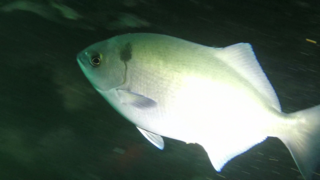
The halfmoon, also known as the blue perch, is a species of marine ray-finned fish, a sea chub from the subfamily Scorpidinae, part of the family Kyphosidae. It is native to the coasts of the eastern Pacific Ocean off western North America. It is fished for using hook and line and it is a desirable food fish.

The silver sweep, also known as the false pompano, sweep, trumps or windawindawi, is a species of marine ray-finned fish from the subfamily Scorpidinae of the sea chub family Kyphosidae. It is native to the southwestern Pacific Ocean from Australia to New Zealand.

The parore also known as luderick, black bream, black snapper or blackfish is a species of marine ray-finned fish, a sea chub from the family Kyphosidae which is found in the southwestern Pacific Ocean off Australia and New Zealand. Parore or paraore is the common name in New Zealand but in Australia luderick is preferred.

The porae, the grey morwong, blue morwong, butterfish, Douglas' morwong, Eastern blue morwong, great perch, queen snapper, rubberlip morwong or silver morwong, is a species of marine ray-finned fish, traditionally regarded as belonging to the family Cheilodactylidae, the members of which are commonly known as morwongs. It is found around south eastern Australia and the north eastern coast of the North Island of New Zealand at depths of about 10 to 100 metres, on sandy and rocky coasts.

Blue moki is a species of marine ray finned fish belonging to the family Latridae, the trumpeters. It is native to the southwestern Pacific Ocean around New Zealand and occasionally off southeastern Australia at depths of 10 metres (33 ft) and greater. Juveniles inhabit inshore waters, preferring rocky reefs while adults mostly occur in offshore waters forming schools over open bottoms. Some solitary adults can be found on reefs. This species can reach a length of 80 centimetres (31 in) FL, though most do not exceed 63 centimetres (25 in) TL. This species is commercially important and is also popular as a game fish.
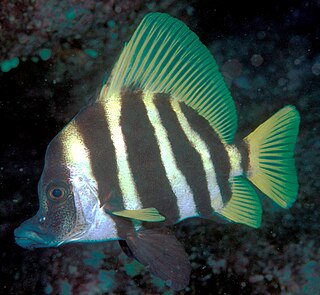
The striped boarfish, also known as whiskered boarfish, Japanese boarfish, sailfin armourhead or whiskered armorhead, is a species of marine ray-finned fish, an armourhead of the family Pentacerotidae, which is native to the Pacific Ocean from the Hawaiian Islands westward to the coast of Asia and Australia. This is a reef-dwelling fish found at depths between 18 and 193 m. It can reach a total length of 90 cm (35 in). It is currently the only known member of the genus Evistias.
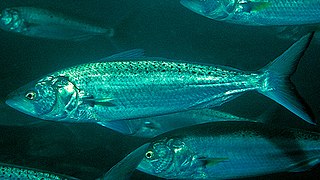
Arripis trutta, known as the Australian salmon in Australia and as kahawai in New Zealand, is a South Pacific marine fish and one of the four extant species within the genus Arripis, native to the cooler waters around the southeastern Australian coasts and the New Zealand coastline. Other common names for this species include Eastern Australian salmon, bay trout, blackback salmon, buck salmon, cocky salmon, colonial salmon, newfish and salmon trout.

The toadstool groper, also known as the Pacific rockcod, Pacific perch, Strawberry cod and whitespotted sea bass is a sea bass of the subfamily Anthiinae of the family Serranidae, is found in the southern Pacific Ocean. Its length is between 20 and 40 cm.
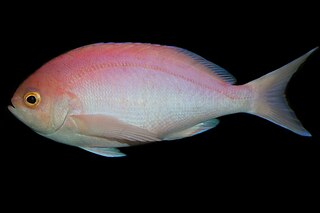
The pink maomao, also known as the longfin perch, is a species of marine ray-finned fish, a member of the subfamily Anthiinae which is part of the grouper and sea bass family Serranidae. It is found in the southern Pacific and the southeastern Indian Ocean.

The yellowspotted sawtail, or spotted sawtail, is a species of marine ray-finned fish belonging to the family Acanthuridae, the surgeonfishes, unicornfishes and tangs. This fish is found in the southwest Pacific Ocean.
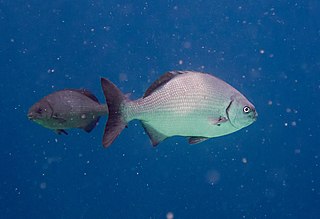
Kyphosus sectatrix, the Bermuda chub, Pacific drummer, beaked chub, grey drummer, Pacific chub or white chub, is a species of marine ray-finned fish, a sea chub from the family Kyphosidae. This species is found in tropical and subtropical coastal waters worldwide. It has had a confused taxonomic history dating back to Linnaeus's naming of the species in 1758.

The inscribed wrasse is a species of marine ray-finned fish from the family Labridae, the wrasses. It is found in the southwestern Pacific Ocean.

The lunar fusilier, also known as the blue fusilier or moon fusilier, is a species of marine ray-finned fish, a fusilier belonging to the family Caesionidae. It is widespread throughout the tropical waters of the Indo-West Pacific area.

Kyphosus azureus, the zebra-perch sea chub, zebra perch or zebra sea chub, is a species of marine ray-finned fish, a sea chub from the family Kyphosidae which is native to the eastern Pacific Ocean coasts of North America.

Kyphosus ocyurus, the blue-striped chub or rainbow chub, is a species of marine ray-finned fish, a sea chub from the family Kyphosidae. The species is found in the Pacific Ocean where it prefers rocky substrates.
Arripis xylabion, the giant kahawai, northern kahawai or Kermadec kahawai, is a species of marine ray-finned fish, one of the four species in the genus Arripis, which is the only genus in the family Arripidae. It is endemic to the south-western Pacific Ocean.

Kyphosus bigibbus, the brown chub, grey drummer, darkfin drummer, insular rudderfish, grey chub, grey sea chub, southern drummer or topsail drummer is a species of marine ray-finned fish, a sea chub from the family Kyphosidae. It is a herbivorous species which is found in subtropical and tropical seas worldwide.

Kyphosus vaigiensis, the brassy chub, brassy drummer, long-finned drummer, low-finned drummer, Northern silver drummer, Queensland drummer, Southern drummer, blue-bronze sea chub, brassy rudderfish, yellow seachub, large-tailed drummer, low-finned chub or long-finned rudderfish, is a species of marine ray-finned fish, a sea chub from the family Kyphosidae. It is a largely herbivorous species which has a circumglobal distribution. Studies in the 21st Century appear to have shown that some other species in the genus Kyphosus are junior synonyms of this taxon.

Callanthias australis, the magnificent sea perch, splendid perch, glorious groppo or Northern splendid perch, is a species of marine ray-finned fish belonging to the family Callanthiidae. This species is found in the southeastern Indian Ocean and the southwestern Pacific Ocean.
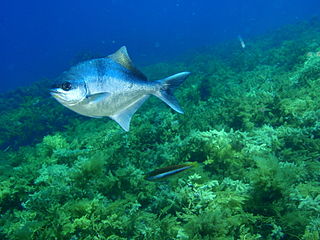
The sea sweep, also known as the maomao, snapjack, sweep is a species of marine ray-finned fish from the subfamily Scorpidinae of the sea chub family Kyphosidae. It is native to the southwestern Pacific Ocean from Australia to New Zealand.



















